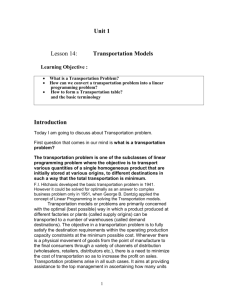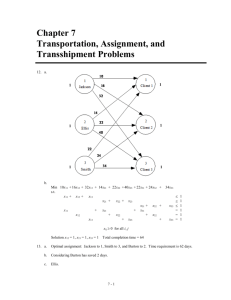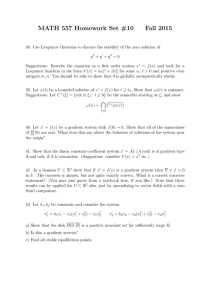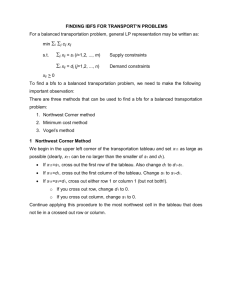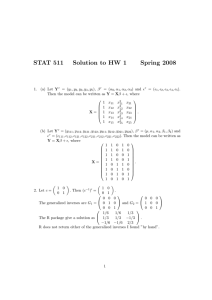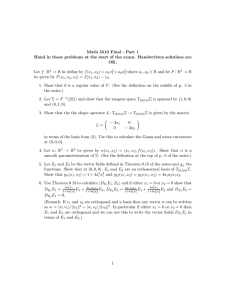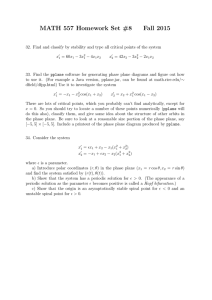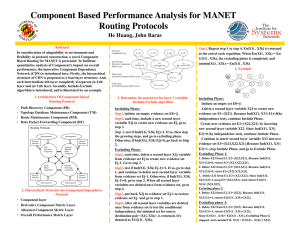Week 8: Transport Model 1
advertisement
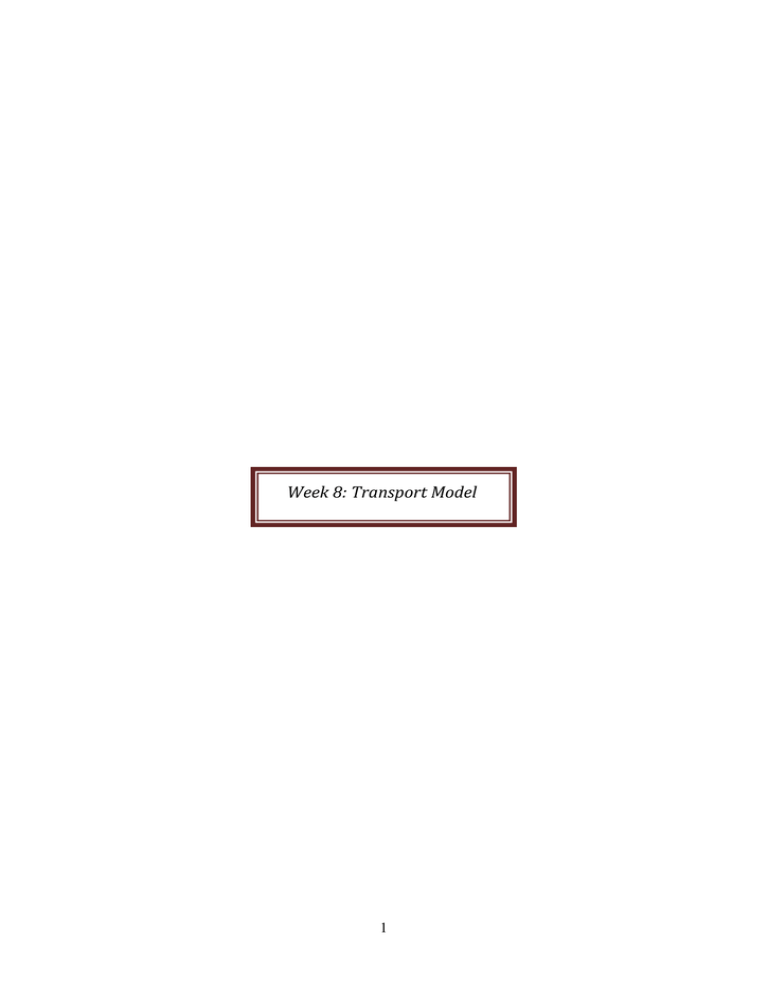
Week 8: Transport Model 1 1.Transport Model The transportation model is a special class of linear programs that deals with shipping a commodity from sources to destinations . The objective is to determine the shipping schedule that minimizes the total shipping cost while satisfying supply and demand limits. The application of the transportation model can be extended to other areas of operation, including inventory control, employment scheduling, and personnel assignment. 2. Formulating Transportation Problems transportation problem is represented by the network in figure (1), there are m sources and n destinations, each represented by a node. the arcs represent the routes linking the sources and the destinations. arc (i, j) joining source i to destination j carries two pieces of information: the transportation cost per unit, cij' and the amount shipped, xij' the amount of supply at source i is ai and the amount of demand at destination j is bj . the objective of the model is to determine the unknowns xij that will minimize the total transportation cost while satisfying all the supply and demand restrictions. Figure 1: Representation of the transportation model with nodes and arcs The relevant data can be formulated in a transportation tableau as: 2 If total supply equals total demand then the problem is said to be a balanced transportation problem. Example 1: MG Auto has three plants in Los Angeles, Detroit, and New Orleans, and two major distribution centers in Denver and Miami. The capacities of the three plants during the next quarter are 1000, 1500, and 1200 cars. The quarterly demands at the two distribution centers are 2300 and 1400 cars. The mileage chart between the plants and the distribution centers is given in Table 1.The trucking company in charge of transporting the cars charges 8 cents per mile per car. The transportation costs per car on the different routes, rounded to the closest dollar, are given in Table 2. 3 Table 1:Mileage Cgart Denver Miami Los Angeles 1000 2690 Detroit 1250 1350 New Orleans 1275 850 Table 2:transportation cost per car Denver(1) Miami(2) Los Angeles(1) $80 $215 Detroit(2) $100 $108 New Orleans (3) $102 $68 The LP model of the problem is given as Minimize z = 80x11 + 215x12 + 100x21 + 108x22 + 102x31 + 68x32 Subject to X11+x12 =1000 (Los Angeles) +x21+x22 =1500 (Detroit) +x31+x32 =1200 (New Oreleans) X11 +x21 +x31 =2300 (Denver) X21+ x22+ x32 =1400 (Miami) xij≥0 , i=1,2,3 ,j=1,2 These constraints are ail equations because the total supply from the three sources (= 1000 + 1500 + 1200 = 3700cars) equals the total demand at the two destinations (= 2300 + 1400 = 3700 cars). The LP model can be solved by the simplex method. However, with the special structure of the constraints we can solve the problem more conveniently using the transportation tableau shown in Table (3) 4 Table 3: transportation tableau of MG Denver Los Angeles Miami 80 X11 100 Demand 215 1000 108 1500 X12 Detroit New Orleans Supply X21 X22 102 X31 68 X32 2300 1200 1400 The optimal solution in Figure (2) calls for shipping 1000 cars from Los Angeles to Denver, 1300 from Detroit to Denver, 200 from Detroit to Miami, and 1200 from New Orleans to Miami. lhe associated minimum transportation cost is computed as 1000 x $80 + 1300 x $100 + 200 x $108 + 1200 x $68 = $313,200. Figure 2 : Optimal solution of MG Auto model Example 2: Powerco has three electric power plants that supply the needs of four cities. Each power plant can supply the following numbers of kwh of electricity: plant 1, 35 million; plant 2, 50 million; and plant 3, 40 million. The peak power demands in these cities as follows (in kwh): city 1, 45 million; city 2, 20 million; city 3, 30 million; city 4, 30 million. The costs of sending 1 million kwh of electricity from plant to city is given in the table below. To minimize the cost of meeting each city’s peak power 5 demand, formulate a balanced transportation problem in a transportation tableau and represent the problem as a LP model. from Plant 1 Plant 2 Plant 3 To City1 $8 $9 $14 City2 $6 $12 $9 City3 $10 $13 $16 City4 $9 $7 $5 Solution: Representation of the problem as a LP model xij: number of (million) kwh produced at plant i and sent to city j. min z = 8 x11 + 6 x12 + 10 x13 + 9 x14 + 9 x21 + 12 x22 + 13 x23 + 7 x24 + 14 x31 + 9 x32 + 16 x33 + 5 x34 s.t. x11 + x12 + x13 + x14 < 35 (supply constraints) x21 + x22 + x23 + x24 < 50 x31 + x32 + x33 + x34 < 40 x11 + x21 + x31 > 45 (demand constraints) x12 + x22 + x32 > 20 x13 + x23 + x33 > 30 x14 + x24 + x34 > 30 xij > 0 (i = 1, 2, 3; j = 1, 2, 3, 4) formulation of the transportation problem in transport tableau as: 3. Balancing the Transportation Model The transportation algorithm is based on the assumption that the model is balanced, meaning that the total demand equals the total supply. If the model is unbalanced, we can always add a dummy source or a dummy destination to restore balance. 6 3.1 Excess Supply If total supply exceeds total demand, we can balance a transportation problem by creating a dummy demand point that has a demand equal to the amount of excess supply. Since shipments to the dummy demand point are not real shipments, they are assigned a cost of zero. These shipments indicate unused supply capacity. 3.2 Unmet Demand If total supply is less than total demand, actually the problem has no feasible solution. To solve the problem it is sometimes desirable to allow the possibility of leaving some demand unmet. In such a situation, a penalty is often associated with unmet demand. This means that a dummy supply point should be introduced. 7
